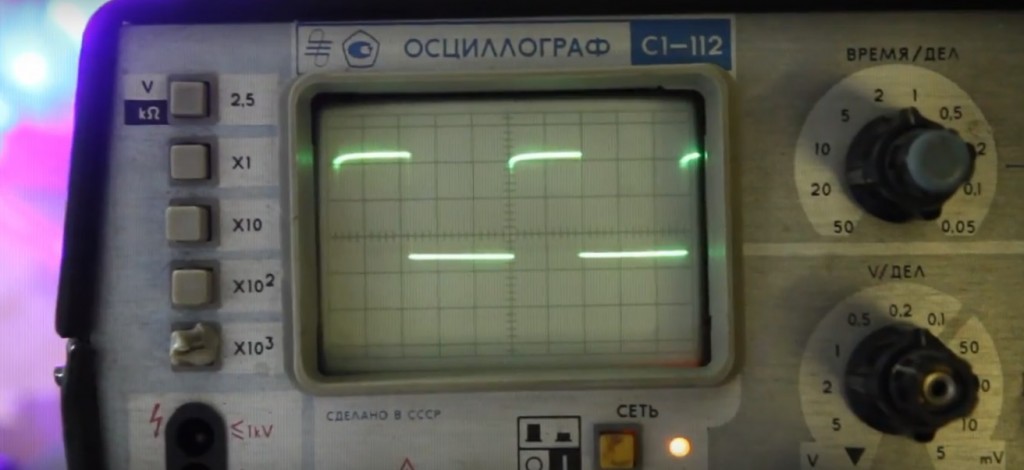We made a few experiments with an 8.5 watt and a 10 watt lasers.
Our primary goal was to measure the laser power consumption in the continuous and pulse mode.
It is considered that in the pulse mode the laser can generate higher power that is why we need to find out what duty ratio and frequency period (time to launch) would be the best to get the highest laser power output.
It is quite easy to measure everything in the continuous mode (you may use a multimeter and an oscilloscope), however, to measure the voltage and current in the pulse mode is more complicated.
In the short impulse we need to measure voltage, voltage peak, average current and peak current.
This requires 4 additional resistors with 1 Ohm and 5 watt capacity connected in series.
The voltage drop on resistors equals the current in the whole circuit (according to Ohm’s law).
We also checked if there was any voltage jump on different DC/DC “Buck” (step down) converters and if there was any voltage drop-down after a load appearance in the form of a laser diode.
All DC/DC converters behave pretty stable and do not have any signs of voltage drops or voltage jumps.
Before the experiments we believed that the best results would be with a duty ratio of 90-95% and frequency in the the range of 50 – 500 Hz.
About laser driver
A real laser driver will have no controls for voltage. It is 100% focused on regulating current. Providing inrush suppressing which looks like a curved rise on a scope but still happens within millisecond time frames, overshoot prevention and will clean up the output which is very important on buck/boost based drivers due to how they chop up the incoming voltage on a buck to amplify current or chop the incoming amperage to amplify the voltage the source is able to draw. With these every cycle is very harsh to the diode and can cause random deaths and
will take significant amount of life off the diode.
On a good test load you can observe exactly how stable the driver is.
We made a table comparing the laser power output vs. the voltage & current.
Continuous mode
Measuring of laser power consumption, current & voltage.
8.5 watt upgraded version | |||||
| DC/DC, voltage, V | 4.8 | 4.9 | 5 | 5.1 | 5.2 |
| Laser diode voltage, V | 4.3 | 4.4 | 4.5 | 4.47 | 4.5 |
| Current, I | 5.13 | 5.55 | 5.9 | 6.9 | 7.2 |
| Laser heat power, Watt | 3.35 | 3.3 | 3.35 | 3.4 | 3.5 |
| Average optical power, Watt | 6.7 | 6.6 | 6.7 | 6.8 | 7 |
| Peak optical power, Watt | 8.375 | 8.25 | 8.375 | 8.5 | 8.75 |
| Laser heat power stability | stable | slightly decreasing | moderately decreasing | rapidly decreasing | rapidly decreasing |
10 watt upgraded version (with new heatsinks) | |||||
| DC/DC, voltage, V | 4.8 | 4.9 | 5 | 5.1 | 5.2 |
| Laser diode voltage, V | 4.6 | 4.7 | 4.9 | 4.9 | 4.9 |
| Current, I | 7.4 | 8.1 | 9.2 | 9.4 | 9.4 |
| Laser heat power, Watt | 4.4 | 4.9 | 5.2 | 5.25 | 5.3 |
| Average optical power, Watt | 8.8 | 9.8 | 10.4 | 10.5 | 10.6 |
| Peak optical power, Watt | 11 | 12.25 | 13 | 13.125 | 13.25 |
| Laser heat power stability | stable | slightly decreasing | modest decreasing | rapid decreasing | rapid decreasing |
An entire live video process
Conclusion
At the end we found out that the laser power cunsumption remains the same in a continuous and in a impulsive modes.
It means that the laser diode consumes the same current in both variants while having a stable voltage.
There is no difference running the laser in an impulsive or continuous modes.
[next step will be to measure optical power in an impulsive and continuous modes]
